Goodness of Fit#
In the previous sections you have studied the different mathematical models (continuous distribution functions) that we can use to model the univariate uncertainty of a random variable and how to fit them based on observations. Also, you have been introduced to some methods to fit those models. But how do I choose between different models?
The choice of the appropriate distribution function needs to be based first on the physics of the random variable we are studying. For instance, if I am studying the concentration of a gas in the atmosphere, negative values do not have a physical meaning, so the selected distribution function should not provide with those estimations.
Once we have accounted for the physical characteristics of the random variable, we can make use of goodness of fit (GOF) techniques to support our decision. This is, GOF techniques are not a ground truth, but an objective way of comparing models. Different techniques may lead to different judgments and it is you as expert who has to balance those outputs and select the best model to your judgment. Thus, it is recommended to use more than one GOF technique in the decision-making process. In the subsequent sections, some commonly used GOF techniques in the statistics field are presented.
In order to illustrate these techniques, the following toy example will be used. The set of observations is represented in the plots below by its pdf and cdf. A Gaussian (\(N(5.17, 5.76)\)) and an Exponential distributions (\(Expon(-5.25, 10.42)\)) are fitted to the data. GOF techniques will be applied to determine which one of the two models fits the data best.
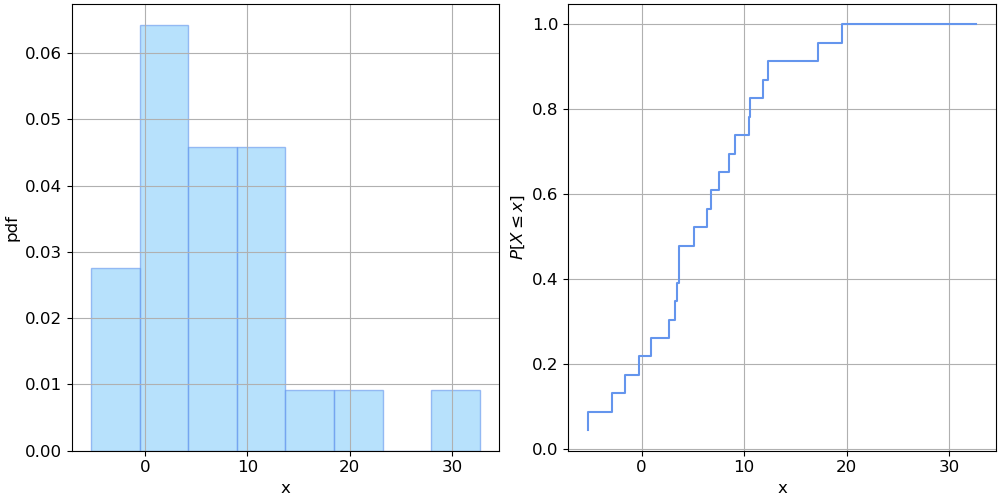
Fig. 5.23 Data overview.#
Graphical methods#
GOF graphical methods are useful tools to have a first intuition of how different models are performing and confirm the results of other quantitative analysis. Here, you are introduce to three techniques: (1) QQ-plot, (2) Log-scale, and (3) Probability plot.
QQ-plot#
This technique is as simple as comparing the observations used to fit the model with the predictions of the model. Typically, the observations are represented in the x-axis and the predictions in the y-axis. Therefore, the perfect fit would be represented by the \(45 ^\circ\)-line.
Let’s see it applied to the example data. Note that the term “quantile” is used in statistics to denote the values of the random variable.
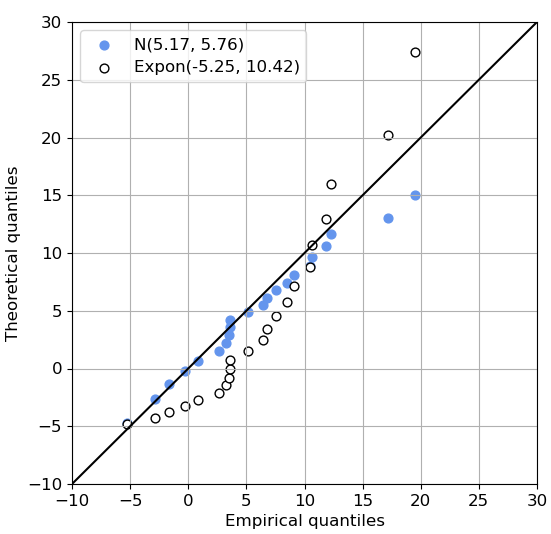
Fig. 5.24 QQ-plot.#
In the QQ-plot, it is shown how the predictions given by the Gaussian distribution (in blue) closely follow the \(45 ^\circ\)-line. Those provided by the Exponential distribution are way further, detaching significantly from the \(45 ^\circ\)-line in the upper tail. Based on this graphical technique, it is possible to conclude that Normal distribution seems to be a better model for the data.
Let’s code it!
Pseudo code is presented to illustrate the procedure to build a QQ-plot.
read observations
#calculate the empirical cdf
p_emp, q_emp = empirical CDF of observations
#define the parameters of the Gaussian distribution
mean_gaussian = 5.17
sd_gaussian = 5.76
#compute the values of the random variable predicted by the Normal distribution
q_gaussian = CDF of Normal distribution evaluated in p_emp with parameters mean_gaussian and sd_gaussian
#define the parameters of the Exponential distribution
loc_expon = -5.25
scale_expon = 10.42
#compute the values of the random variable predicted by the fitted distribution
q_exponential = CDF of Exponential distribution evaluated in p_emp with parameters loc_expon, scale_expon
scatterplot of q_emp versus q_gaussian
scatterplot of q_emp versys q_expon
Log-scale#
As previously introduced, the tails of the distributions are key to allow the inference of values which have not been observed yet. Therefore, it is important to check whether the distribution used to model the observations is performing properly in that region. A simple trick to do so is to use a logarithmic scale (log-scale) to represent the exceedance probability plot. That way, we “zoom in” on those points in the tail instead of focusing on the bulk of the data. In the figure below, the representation of the cdf in regular and log-scale is shown.
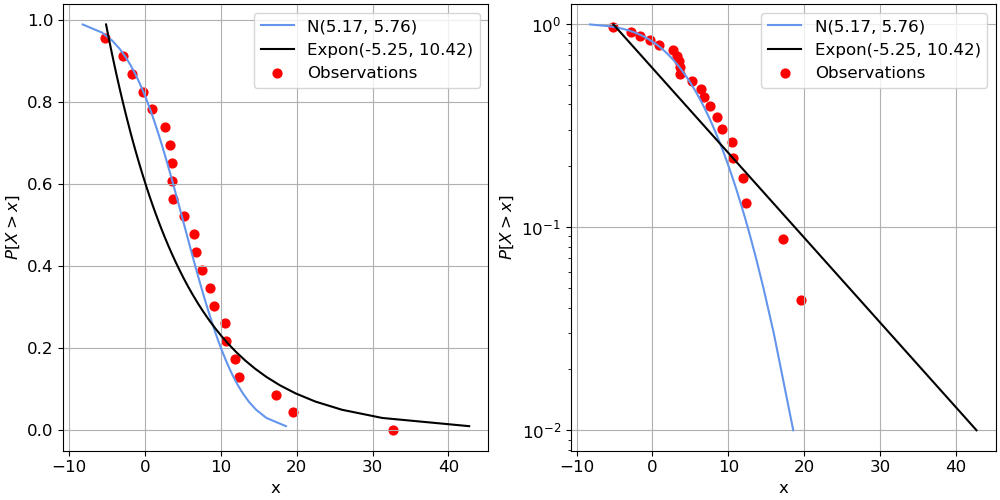
Fig. 5.25 Exceedance probability plot represented both in regular and logarithmic scale.#
Analyzing the figure on the left side, it can be seen that the observations follow better the Normal distribution. However, it is not clear which one of the two distributions is performing better in the tail. By analyzing the plot on the right side, it is possible to answer that question. Again, it is observed that the data points follow better the Gaussian distribution. However, observations in the tail are not that well represented by the Gaussian distribution, being even closer to the Exponential distribution. Thus, since none of the considered distributions performs properly in the tail, it may be needed to consider another distribution to model the asymmetry of the data, such as the Gumbel or Lognormal distributions.
Probability plot or probability paper#
This graphical technique consists on adapting the axis of the plot of the cdf accounting for the parametric distribution fitted so it is presented as a line. This is, the cdf of any Gaussian distribution will be plotted as a line in the Normal probability plot. Thus, in the x-axis a function of the values of the random variable is presented, while in the y-axis a function of the non-exceedance probabilities is shown.
Let’s see it with the example of the Exponential distribution. Its cdf is given by
where \(\lambda\) is the scale parameter and \(\mu\) is the location parameter. A transformation is performed on the cdf so a linear relationship is established between the value of the random variable X and the non-exceedance probabilities. In the case of the Exponential distribution, it is just a matter of calculating logarithms to both sides of the equation as
In this manner, there is a linear relationship between \(ln[1-F(x)]\) and \(x\). Note that in the case of the Exponential distribution, the probability plot is the same as the log-scale! Therefore, the Exponential distribution was shown as a straight line in the previous plot, while the Gaussian distribution was not.
Formal hypothesis test: Kolmogorov-Smirnov test#
Kolmogorov-Smirnov (KS) test is one of the most popular nonparametric formal hypothesis tests in statistics. It can be used with two purposes: (1) to compare a sample with a reference parametric distribution, and (2) to compare two samples. Here, the first option is considered since it is the one used for GOF purposes. Thus, this test aims to determine how likely is that a sample was drawn from the reference parametric distribution.
This test is based on the KS statistic, which is (roughly) the maximum distance between the empirical cumulative distribution and the parametric distribution fitted to those observations. This statistic is mathematically defined as
where \(D_n\) is the KS statistic, \(sup_x\) is the supremum of the set distances (intuitively, the largest absolute difference between the two distribution functions across all the values of the random variable \(X\)), \(\hat{F}(x)\) is the empirical cumulative distribution and \(F(x)\) the fitted parametric cumulative distribution.
Once \(D_n\) is computed, a formal hypothesis test is performed. The null hypothesis corresponds to \(\hat{F}\) having the same distribution as \(F\). In mathematical terms:
The distribution of \(D_n\) has been already calculated and included in different statistic packages, since it depends on the considered parametric distribution. These distributions can be used to calculate the probability of the null hypothesis being true (called \(p-value\)). A significance level needs to be selected (typically, \(\alpha=0.05\)) as a threshold to determine whether the null hypothesis is rejected or accepted. This is, if the probability of \(H_0\) being true (\(p-value\)) is below \(\alpha\), \(H_0\) is rejected, so the empirical cumulative distribution is not coming from the fitted parametric cumulative distribution.
Let’s see it in an example. In the figure below, both the empirical distribution (step function) and the fitted normal distribution are shown. The maximum distance between both distributions is also presented in red.
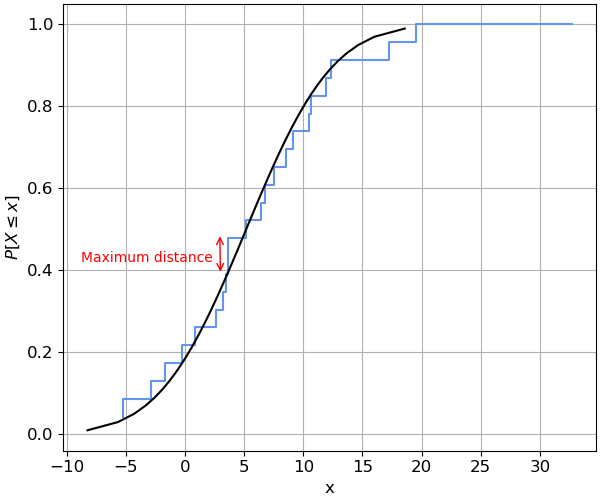
Fig. 5.26 Maximum distance between the empirical and fitted normal distribution (\(D_n\)).#
If we compute the KS statistic using the distribution already implemented in software (Scipy package, in this case), \(D_n = 0.12\) is obtained which (roughly) corresponds to what is shown in the previous plot.
After that, the \(p-value\) is also computed, obtaining \(p-value = 0.93\). This means that the probability of the null hypothesis (\(H_0: \hat{F} \sim F\), the sample comes from the parametric distribution) being true is 0.93. Thus, considering a significance level \(\alpha = 0.05\), \(pvalue=0.93>\alpha=0.05\), so I cannot reject the null hypothesis.
Let’s practice#
An engineer is characterizing the axle loads transmited by the traffic on a bridge. Based on the observations, a Normal and a Gumbel distributions are fitted, as shown in the figure below.
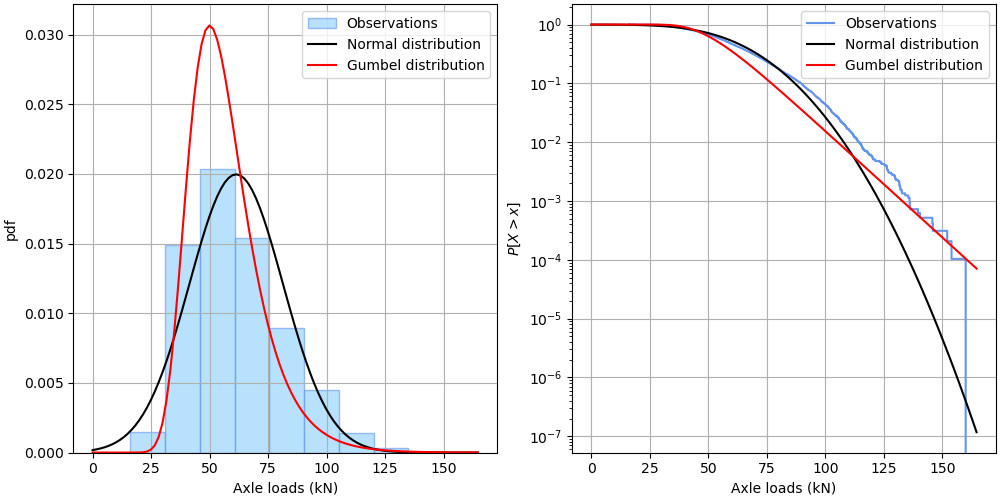
Fig. 5.27 Comparison between the observations of axel loads and the fitted Normal and Gumbel distributions: (a) PDF, and (b) Exceedance curve.#
The engineer needs to select a parametric distributions since he/she needs to infer extreme loads that have not been observed yet. In order to decide which distribution to apply for further analysis, the engineer has plotted the Exceedance Curve (1-CDF) in log-scale (previous figure) and has performed the Kolmogorov-Smirnov test. The results are:
Normal distribution: \(p-value \approx 0.07\)
Gumbel distribution: \(p-value \approx 0\)
Which distribution should be chosen by the engineer?
Answer
According to the Kolmogorov-Smirnov test, it is not possible to reject that the observations are coming from a Normal distribution, while it is possible to do so for the Gumbel distribution. Therefore, if we would only trust on the Kolmogorov-Smirnov test, Normal distribution would be chosen.
However, the plot in log-scale is also available. There, it is shown how the Gumbel distribution fits way better the tail of the empirical distribution. Since the goal of the engineer is to infer events that have not been observed yet (extrapolate), the tail is extremely important. Consequently, Gumbel distribution would be preferred in this context to model the axel loads observations.
Attribution
This chapter was written by Patricia Mares Nasarre and Robert Lanzafame. Find out more here.
